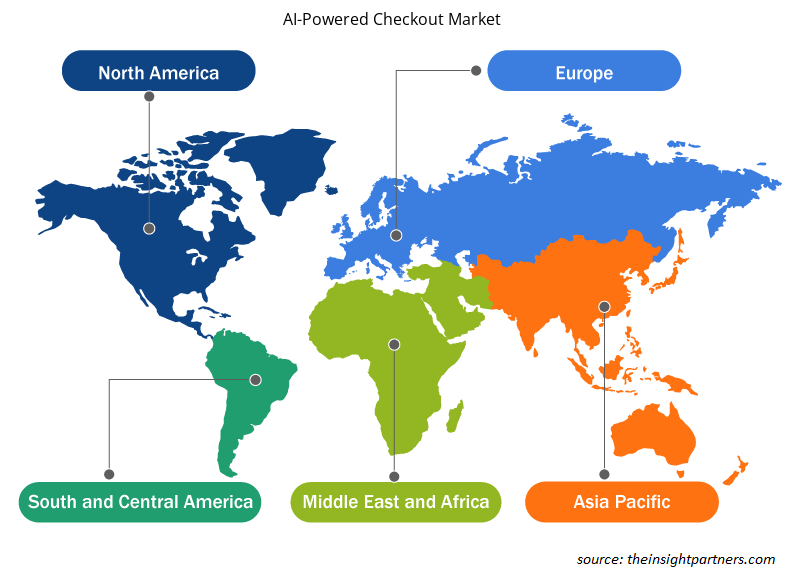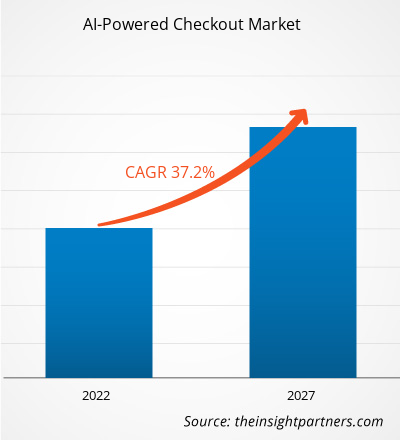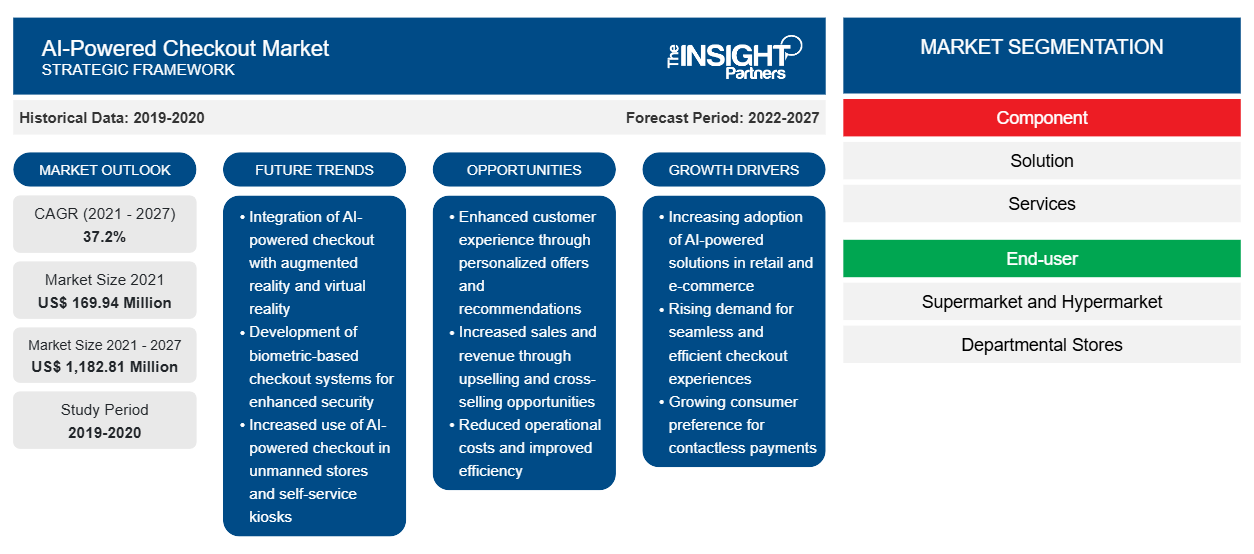Nel 2021, il mercato dei sistemi di pagamento basati sull'intelligenza artificiale è stato valutato 169,94 milioni di dollari e si prevede che crescerà a un CAGR del 37,2% nel periodo di previsione dal 2021 al 2027.
Il checkout basato sull'intelligenza artificiale offre vari vantaggi, come installazione rapida e semplice, riduzione della coda nei negozi, riduzione dei costi di manodopera, miglioramento dell'esperienza del cliente e aumento dei margini di profitto. Stanno quindi aumentando l'accettazione del checkout basato sull'intelligenza artificiale, che innesca la crescita del mercato del checkout basato sull'intelligenza artificiale. Inoltre, la crescente digitalizzazione nei negozi al dettaglio, unita all'aumento del numero di negozi al dettaglio, supermercati e ipermercati in tutto il mondo, offre un'opportunità redditizia per l'operatore del mercato del checkout basato sull'intelligenza artificiale.
La pandemia di COVID-19 continua a imporre la chiusura temporanea dei negozi al dettaglio nel mercato globale, segnalando un'interruzione senza precedenti del commercio. I rivenditori e i marchi stanno affrontando varie sfide a breve termine in materia di salute e sicurezza, catena di fornitura, forza lavoro, flusso di cassa, domanda dei consumatori e marketing. In Nord America, i negozi hanno iniziato a chiudere all'inizio di marzo e si prevede che questa tendenza continuerà mentre città e stati lottano per contenere la diffusione del virus.
Il mercato delle casse alimentate dall'intelligenza artificiale è stato segmentato in base a componente, utente finale e area geografica. In base al componente, il mercato è segmentato in soluzioni e servizi. Il segmento delle soluzioni ha rappresentato la quota maggiore del mercato complessivo durante il periodo di previsione, a causa del crescente numero di progressi tecnologici nella visione artificiale, nel riconoscimento facciale, nei sensori per scaffali, nei codici a barre, nei codici a risposta rapida (QR) e nei tag RFID. Tuttavia, si prevede che il segmento dei servizi sarà il componente delle casse alimentate dall'intelligenza artificiale in più rapida crescita. Inoltre, il mercato delle casse alimentate dall'intelligenza artificiale è segmentato in supermercati e ipermercati, grandi magazzini e altri in base all'utente finale. Nel 2019, supermercati e ipermercati detenevano una quota sostanziale nel mercato globale delle casse alimentate dall'intelligenza artificiale . Mentre si prevede che altri segmenti cresceranno al CAGR più elevato dal 2020 al 2027.
Personalizza questo report in base alle tue esigenze
Riceverai la personalizzazione gratuita di qualsiasi report, comprese parti di questo report, o analisi a livello nazionale, pacchetto dati Excel, oltre a usufruire di grandi offerte e sconti per start-up e università
-
Scopri le principali tendenze di mercato in questo rapporto.Questo campione GRATUITO includerà analisi di dati che spaziano dalle tendenze di mercato alle stime e alle previsioni.
Approfondimenti sul mercato del checkout basato sull'intelligenza artificiale
Aumento dell'adozione di nuove tecnologie nel settore della vendita al dettaglio
Il crescente impatto dell'e-commerce e i continui cambiamenti nelle preferenze dei consumatori sono tra le ragioni principali che hanno portato alla stagnazione delle prestazioni del settore della vendita al dettaglio tradizionale. Alcuni degli operatori del mercato dell'e-commerce stanno espandendo vigorosamente le loro attività commerciali offline per assicurarsi una quota maggiore di quella di mercato esistente. Considerando ciò, i rivenditori che operano in tutto il mondo sono anche costantemente alla ricerca di strategie più efficaci per guidare la crescita dei loro ricavi. Prima dell'introduzione dell'automazione nel settore della vendita al dettaglio, i rivenditori hanno dovuto affrontare una pressione enorme per superare le aspettative dei clienti e migliorare l'efficienza organizzativa. I checkout basati sull'intelligenza artificiale offrono la possibilità di superare tutte le sfide che devono affrontare, aiutandoli ulteriormente ad automatizzare i loro flussi di lavoro e i molteplici processi che semplificano le loro operazioni.
Approfondimenti di mercato basati sui componenti
In base al componente, il mercato del checkout basato sull'intelligenza artificiale è segmentato in soluzioni e servizi. La soluzione di checkout basata sull'intelligenza artificiale è fornita a diversi punti vendita al dettaglio. Ciò aiuta i rivenditori a offrire ai clienti un'esperienza di acquisto migliore eliminando la necessità di stare in lunghe code per effettuare i pagamenti degli articoli acquistati. Inoltre, questo software è fornito con una serie di servizi che aiutano i rivenditori a risolvere i loro reclami ogni volta che ne hanno bisogno.
Approfondimenti di mercato basati sull'utente finale
In base all'utente finale, il mercato delle casse basate sull'intelligenza artificiale è segmentato in grandi magazzini, supermercati e ipermercati e altri. La soluzione di cassa basata sull'intelligenza artificiale sta guadagnando un grande slancio in diversi punti vendita al dettaglio per eliminare la necessità di stare in lunghe code per effettuare i pagamenti. Con il crescente numero di punti vendita al dettaglio, la portata dell'integrazione di tecnologie avanzate e autonome in essi sta aumentando.
Gli operatori che operano nel mercato del checkout basato sull'intelligenza artificiale si concentrano su strategie, come iniziative di mercato, acquisizioni e lanci di prodotti, per mantenere le loro posizioni nel mercato del checkout basato sull'intelligenza artificiale. Ecco alcuni sviluppi da parte degli operatori chiave del mercato del checkout basato sull'intelligenza artificiale:
Nel luglio 2020, AiFi ha annunciato l'intenzione di implementare 330 negozi autonomi nuovi e ristrutturati entro la fine del 2021.
Nel gennaio 2020, Focal Systems ha annunciato una partnership con Connors Group per fornire risultati significativi ai rivenditori combinando le tecnologie di entrambe le aziende.
Approfondimenti regionali sul mercato dei pagamenti basati sull'intelligenza artificiale
Le tendenze regionali e i fattori che influenzano il mercato AI-Powered Checkout durante il periodo di previsione sono stati ampiamente spiegati dagli analisti di Insight Partners. Questa sezione discute anche i segmenti e la geografia del mercato AI-Powered Checkout in Nord America, Europa, Asia Pacifico, Medio Oriente e Africa e America meridionale e centrale.

- Ottieni i dati specifici regionali per il mercato dei pagamenti basati sull'intelligenza artificiale
Ambito del rapporto di mercato sui pagamenti basati sull'intelligenza artificiale
| Attributo del report | Dettagli |
|---|---|
| Dimensioni del mercato nel 2021 | 169,94 milioni di dollari USA |
| Dimensioni del mercato entro il 2027 | 1.182,81 milioni di dollari USA |
| CAGR globale (2021 - 2027) | 37,2% |
| Dati storici | 2019-2020 |
| Periodo di previsione | 2022-2027 |
| Segmenti coperti |
Per componente
|
| Regioni e Paesi coperti |
America del Nord
|
| Leader di mercato e profili aziendali chiave |
|
Densità dei player del mercato del checkout basato sull'intelligenza artificiale: comprendere il suo impatto sulle dinamiche aziendali
Il mercato del mercato del checkout basato sull'intelligenza artificiale sta crescendo rapidamente, spinto dalla crescente domanda degli utenti finali dovuta a fattori quali l'evoluzione delle preferenze dei consumatori, i progressi tecnologici e una maggiore consapevolezza dei vantaggi del prodotto. Con l'aumento della domanda, le aziende stanno ampliando le loro offerte, innovando per soddisfare le esigenze dei consumatori e capitalizzando sulle tendenze emergenti, il che alimenta ulteriormente la crescita del mercato.
La densità degli operatori di mercato si riferisce alla distribuzione di aziende o società che operano in un particolare mercato o settore. Indica quanti concorrenti (operatori di mercato) sono presenti in un dato spazio di mercato in relazione alle sue dimensioni o al valore di mercato totale.
Le principali aziende che operano nel mercato dei sistemi di pagamento basati sull'intelligenza artificiale sono:
- Società a responsabilità limitata
- AiFi Inc.
- SISTEMI FOCAL INC.
- Azienda di robotica Accel
- Società Toshiba
Disclaimer : le aziende elencate sopra non sono classificate secondo un ordine particolare.

- Ottieni una panoramica dei principali attori del mercato dei checkout basati sull'intelligenza artificiale
Mercato del checkout basato sull'intelligenza artificiale – per componente
- Soluzione
- Servizi
Mercato del checkout basato sull'intelligenza artificiale – per utente finale
- Supermercato e ipermercato
- Grandi magazzini
- Altri
Mercato del checkout basato sull’intelligenza artificiale – per area geografica
-
America del Nord
- NOI
- Canada
- Messico
-
Europa
- Francia
- Germania
- Spagna
- Regno Unito
- Russia
- Resto d'Europa
-
Asia Pacifico (APAC)
- Cina
- India
- Giappone
- Australia
- Corea del Sud
- Resto dell'APAC
-
MEA
- Arabia Saudita
- Emirati Arabi Uniti
- Sudafrica
- Resto del MEA
-
SAM
- Brasile
- Resto del SAM
Mercato del checkout basato sull’intelligenza artificiale – Profili aziendali
- Azienda di robotica Accel
- AiFi Inc.
- SISTEMI FOCAL INC.
- Fujitsu Limited
- Società a responsabilità limitata
- Società NCR
- Cognizione standard
- Società Toshiba
- Trigonometria
- Zippin
- Analisi storica (2 anni), anno base, previsione (7 anni) con CAGR
- Analisi PEST e SWOT
- Valore/volume delle dimensioni del mercato - Globale, Regionale, Nazionale
- Industria e panorama competitivo
- Set di dati Excel
Report recenti
Testimonianze
Motivo dell'acquisto
- Processo decisionale informato
- Comprensione delle dinamiche di mercato
- Analisi competitiva
- Analisi dei clienti
- Previsioni di mercato
- Mitigazione del rischio
- Pianificazione strategica
- Giustificazione degli investimenti
- Identificazione dei mercati emergenti
- Miglioramento delle strategie di marketing
- Aumento dell'efficienza operativa
- Allineamento alle tendenze normative























 Ottieni un campione gratuito per - Mercato dei pagamenti basato sull'intelligenza artificiale
Ottieni un campione gratuito per - Mercato dei pagamenti basato sull'intelligenza artificiale